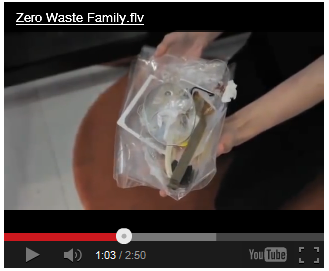I actually searched for over 30 minutes to find out how garbage collection is paid for in my city, before calling a neighbor. My tax statement doesn't indicate it directly, and searching online nets guidelines for what can be thrown away but not how what's thrown away is paid for.
Contrast this to the City of St. Paul, Minnesota. My neighbor's daughter lives there, and when she first arrived, she had to register for garbage collection with one of five or six available companies. She pays a direct bill for this service. The city's site makes it unabashedly clear that the service is for "waste generators".
Five or so years ago, where I live, each household was automatically delivered a 65-gallon "city provided tan-colored refuse cart" and a similar green recycling cart, unless one opted for a smaller or larger cart. Casual observation suggests that the default for most households is the 65-gallon one.
Let's do some math: 65 gallons equals roughly 8.7 cubic feet (.25 cubic meters) in volume. If a city of 100,000 households disposes of an average of 65 gallons of trash each week (some more, some less), that's 870,000 cubic feet (25,000 cubic meters) of garbage per week. The numbers per year are dizzying: 45,240,000 cubic feet (1,300,000 cubic meters).
Compare that to something we've all seen: the semi-truck. A 53' long x 9' high x 8' wide semi holds 3,816 cubic feet worth of cargo volume. They look like this. Our equation above translates to 11,855 semi trucks full of garbage. For one city of 100,000 people. For one year.
Where does it all go?
How do we care enough about what we don't see to be willing to tolerate the inconvenience of reducing our waste?
Maybe St. Paul has the right idea. Call us what we are and charge us for it. Directly.
P.S. In case you're wondering, I opted for the 35-gallon size for both garbage and recycling, and didn't need to take either to the curb today. I haven't gotten completely off disposables -- I have more learning to do and substitutions to make before I would be able to pull that off -- but I've managed to reduce my garbage output (and casual spending) significantly.
The picture below represents four months' worth of garbage for a family of four. Now that's something to shoot for....
 |
| Credit: Zero Waste Blog |
Thanks to friend, Jason, for sending the link.

Very interesting Sarah. Keep writing and sharing.
ReplyDeleteThanks, Bill. Feel free to share your ideas too!
ReplyDelete